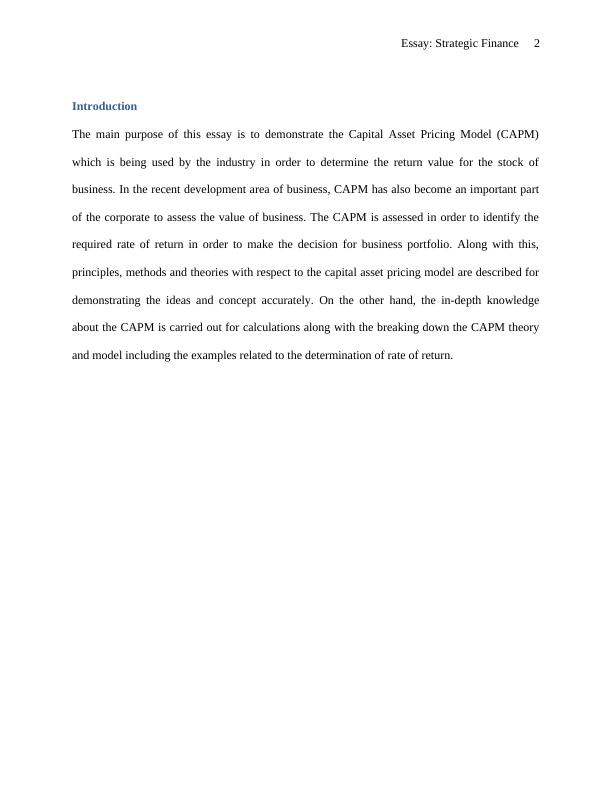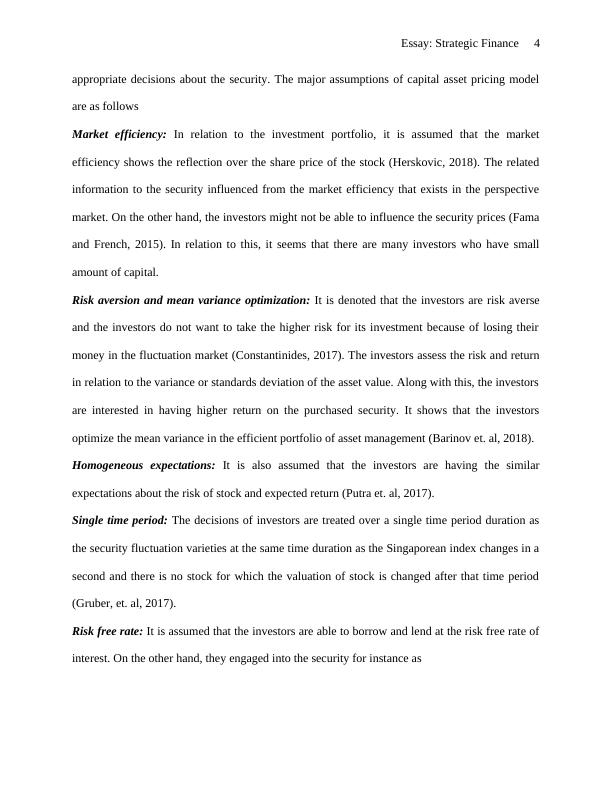Capital Asset Pricing Model (CAPM) and its Implications
Added on 2023-06-04
15 Pages3839 Words346 Views
Essay: Strategic Finance 1
STRATEGIC FINANCE
STRATEGIC FINANCE

Essay: Strategic Finance 2
Introduction
The main purpose of this essay is to demonstrate the Capital Asset Pricing Model (CAPM)
which is being used by the industry in order to determine the return value for the stock of
business. In the recent development area of business, CAPM has also become an important part
of the corporate to assess the value of business. The CAPM is assessed in order to identify the
required rate of return in order to make the decision for business portfolio. Along with this,
principles, methods and theories with respect to the capital asset pricing model are described for
demonstrating the ideas and concept accurately. On the other hand, the in-depth knowledge
about the CAPM is carried out for calculations along with the breaking down the CAPM theory
and model including the examples related to the determination of rate of return.
Introduction
The main purpose of this essay is to demonstrate the Capital Asset Pricing Model (CAPM)
which is being used by the industry in order to determine the return value for the stock of
business. In the recent development area of business, CAPM has also become an important part
of the corporate to assess the value of business. The CAPM is assessed in order to identify the
required rate of return in order to make the decision for business portfolio. Along with this,
principles, methods and theories with respect to the capital asset pricing model are described for
demonstrating the ideas and concept accurately. On the other hand, the in-depth knowledge
about the CAPM is carried out for calculations along with the breaking down the CAPM theory
and model including the examples related to the determination of rate of return.

Essay: Strategic Finance 3
Analysis of CAPM with reference to rate of return
Definition and background information about CAPM
The capital asset pricing model is a method which entails about the determination of relationship
in between the expected return for an asset and systematic risk (KUEHN, et. al, 2017). It is
basically used for the identification of rate of return on particular asset for instance as stock. In
recent years, the usability of CAPM method has evolved as major concept which plays important
role in recognition of risk with a particular stock. It is also applicable in order to establish the
investment portfolio about an asset (Corporatefinanceinstitute, 2018). It can also be defined as
the approach which denotes the expected return on a stock is equal to the return over risk free
plus a risk premium. At the same time, the modern age of financial investment market, CAPM
occupies a crucial position with relation to the investment purpose.
Principles of Capital Asset Pricing Model
CAPM is applied as the economic model in order to assess the value of security, stocks,
derivatives and the assets which are risky in its return aspect (Fama and French, 2017). In
context to the concept and idea of capital asset pricing model, it is assessed that the investors
expect the additional return in the situation of accepting the additional risk. It is also used for
pleasing predictions in order to measuring the risk and return relationship with attribution of a
specific asset. It is developed over the portfolio choice in which the mean and variance about the
risk and return is chosen (He, et. al, 2017).
Assumptions of Capital Asset Pricing Model
CAPM basically envisages the return and risk on an individual risky security. This model of
asset valuation over its risk is based on the assumptions about providing the suitable and
Analysis of CAPM with reference to rate of return
Definition and background information about CAPM
The capital asset pricing model is a method which entails about the determination of relationship
in between the expected return for an asset and systematic risk (KUEHN, et. al, 2017). It is
basically used for the identification of rate of return on particular asset for instance as stock. In
recent years, the usability of CAPM method has evolved as major concept which plays important
role in recognition of risk with a particular stock. It is also applicable in order to establish the
investment portfolio about an asset (Corporatefinanceinstitute, 2018). It can also be defined as
the approach which denotes the expected return on a stock is equal to the return over risk free
plus a risk premium. At the same time, the modern age of financial investment market, CAPM
occupies a crucial position with relation to the investment purpose.
Principles of Capital Asset Pricing Model
CAPM is applied as the economic model in order to assess the value of security, stocks,
derivatives and the assets which are risky in its return aspect (Fama and French, 2017). In
context to the concept and idea of capital asset pricing model, it is assessed that the investors
expect the additional return in the situation of accepting the additional risk. It is also used for
pleasing predictions in order to measuring the risk and return relationship with attribution of a
specific asset. It is developed over the portfolio choice in which the mean and variance about the
risk and return is chosen (He, et. al, 2017).
Assumptions of Capital Asset Pricing Model
CAPM basically envisages the return and risk on an individual risky security. This model of
asset valuation over its risk is based on the assumptions about providing the suitable and

Essay: Strategic Finance 4
appropriate decisions about the security. The major assumptions of capital asset pricing model
are as follows
Market efficiency: In relation to the investment portfolio, it is assumed that the market
efficiency shows the reflection over the share price of the stock (Herskovic, 2018). The related
information to the security influenced from the market efficiency that exists in the perspective
market. On the other hand, the investors might not be able to influence the security prices (Fama
and French, 2015). In relation to this, it seems that there are many investors who have small
amount of capital.
Risk aversion and mean variance optimization: It is denoted that the investors are risk averse
and the investors do not want to take the higher risk for its investment because of losing their
money in the fluctuation market (Constantinides, 2017). The investors assess the risk and return
in relation to the variance or standards deviation of the asset value. Along with this, the investors
are interested in having higher return on the purchased security. It shows that the investors
optimize the mean variance in the efficient portfolio of asset management (Barinov et. al, 2018).
Homogeneous expectations: It is also assumed that the investors are having the similar
expectations about the risk of stock and expected return (Putra et. al, 2017).
Single time period: The decisions of investors are treated over a single time period duration as
the security fluctuation varieties at the same time duration as the Singaporean index changes in a
second and there is no stock for which the valuation of stock is changed after that time period
(Gruber, et. al, 2017).
Risk free rate: It is assumed that the investors are able to borrow and lend at the risk free rate of
interest. On the other hand, they engaged into the security for instance as
appropriate decisions about the security. The major assumptions of capital asset pricing model
are as follows
Market efficiency: In relation to the investment portfolio, it is assumed that the market
efficiency shows the reflection over the share price of the stock (Herskovic, 2018). The related
information to the security influenced from the market efficiency that exists in the perspective
market. On the other hand, the investors might not be able to influence the security prices (Fama
and French, 2015). In relation to this, it seems that there are many investors who have small
amount of capital.
Risk aversion and mean variance optimization: It is denoted that the investors are risk averse
and the investors do not want to take the higher risk for its investment because of losing their
money in the fluctuation market (Constantinides, 2017). The investors assess the risk and return
in relation to the variance or standards deviation of the asset value. Along with this, the investors
are interested in having higher return on the purchased security. It shows that the investors
optimize the mean variance in the efficient portfolio of asset management (Barinov et. al, 2018).
Homogeneous expectations: It is also assumed that the investors are having the similar
expectations about the risk of stock and expected return (Putra et. al, 2017).
Single time period: The decisions of investors are treated over a single time period duration as
the security fluctuation varieties at the same time duration as the Singaporean index changes in a
second and there is no stock for which the valuation of stock is changed after that time period
(Gruber, et. al, 2017).
Risk free rate: It is assumed that the investors are able to borrow and lend at the risk free rate of
interest. On the other hand, they engaged into the security for instance as

End of preview
Want to access all the pages? Upload your documents or become a member.
Related Documents
Understanding the Capital Asset Pricing Model (CAPM)lg...
|10
|2155
|428
Market Line and Capital Assets Pricing Modellg...
|9
|2103
|431
Analyzing the Risk and Return Relationship of CSL Ltd Securitieslg...
|12
|2329
|74
Understanding Risk and Return Measures through CAPM Model and Company Contextlg...
|5
|1235
|209
Capital Asset Pricing Model: Usefulness, Assumptions, and Limitationslg...
|8
|2324
|135
Capital Asset Pricing Model: Recent Developments and Criticismslg...
|10
|2873
|59
